Naturalist’s Notebook: October 10 – October 16
* I doubt I could improve on Dennis Minsky’s observations of October 10. “Amazing behavior: Salt and company lunge-feeding on KRILL out at the Triangle! Wide open mouths and engorged throats! Very exciting. Something new for even veteran whalewatchers!”
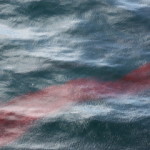
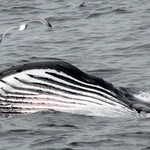
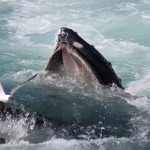
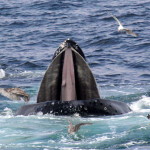

* And there was also the lobtailling of Chromosome in the morning.


* Whalewatching on the 11th of October featured numerous mother and calf pairs. By this time in a humpback calf’s life, its mother has already taught it most of what it needs to know to be a little whale. She is now consentrating on making sure the little one can adequately feed. And that might be what was behind the feeding behavior of Wizard this afternoon. Her calf was closeby, no doubt taking in its mother’s technique.
* Wizard would also have been preparing for the winter. In just a few short weeks, she will likely begin her migration to the warmer tropical seas. When she gets there, however, the warm waters will not offer her the bounty she has enjoyed off our coasts this summer. Those warm waters, so important to the survival of calves and to the intermingling of the Atlantic stock’s gene pool, are very much like a desert for large whales. The clear waters indicate that they are void (or far more so) of the plankton, both plant and animal, that make our coasts so productive. In these tropical waters, the nutrients and energy are absorbed by the coral reef systems before they have the chance to nourish the free-floating plankton that are the food source for the small schooling fish that large whales like Wizard feed on. It will be a long winter for her. And she will loose a great deal of weight and not just because she is living off of the caloric value of her blubber. She will also rely on that blubber as a source of the fresh water her body requires. During the feeding season, the summer, she is utilizing the water content of the fish she is eating to supply her body’s needs. With that food source gone, she will need to hydrolize that water from the layer of blubber she has worked so hard to build while in the feeding grounds.
* Looks at feeding humpbacks continued on October 12. Drawn to the east by a few spouts, the Dolphin 8 soon found herself in the midst of a group of humpbacks blowing bubble nets. This group grew quickly from four to eight or ten and included several mother and calf pairs. The Dolphin 9 reports that by the time it got to the area, the calves had become “frisky” to the delight of its passengers. And by the time the afternoon trips arrived, that friskiness had turned into heightened activity like spinning head breaches and flipper slapping. It also had turned into curiosity. Both Nile’s calf and Baja’s calf took quite an interest in the vessel and investigated it thoroughly.
* If yesterday was just good whalewatching, there is no word for the encounters of October 13. Just like yesterday, the mothers were feeding themselves, preparing for the long winter. And, just like yesterday, the calves were taking advantage of their free time in energetic ways. While their mothers were actively engaged in making a spectacular living, the calves of Milkweed, Wizard, Baja, and Midnight were amusing themselves by flippering, rolling, lobtailling, and breaching. The entire day was nonstop action in all directions. One naturalist observed, “I didn’t know where to tell them to look! There was just so much going on!”
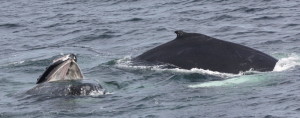

* October 14 began lazy. The light southwest winds and overcast sky were kind of a lolling thing on the trip to the southwest corner of Stellwagen. And the logging of Nile and her calf just seemed to fit in with the laziness of the morning. Once the Dolphin 10 moved further east, however, that changed abruptly. Again, throughout the day, mothers fed and calves played. While intricate bubble nets were being formed on one side of the boat, a calf was rolling on the other. And, while this mother or that broke through the surface with her mouth wide open, gathering thousands of tiny fish, her calf was on the other side of the boat, tail-breaching. Again, this naturalist’s delemma is, which way do I tell them to look?
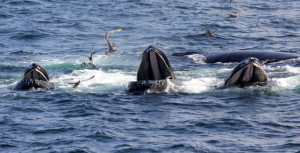

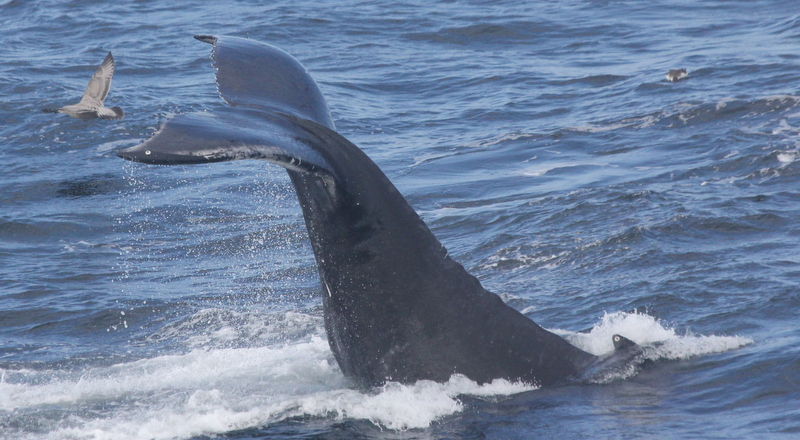
* October 15 was a gorgeous day. It felt like August. And the feeding of the adults continued to the east of the southwest corner. This year’s mothers; like Midnight, Iota, Baja, and Wizard, and old favorites; like Salt, Colt, Dome, and Buckshot, joining in the feeding frenzy.

* And there was also the lively tail-breaching of a whale named Sundown.
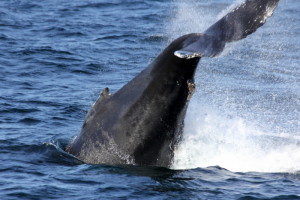

* The increasing winds of yesterday afternoon caused a wild ride on October 16. That did not prevent the Dolphin 10 from finding five humpback whales, including a mother named Baja and her calf. Even with the rolling seas, the pair spent nearly a half hour just off of the stern of the vessel, investigating the large object at the interface of their world and the air. Once their curiosity was sated, they began to nurse. Even now, the calves are still partially dependant on their mothers for sustinence. Thus the continued heavy feeding of the mothers over the past several days.





